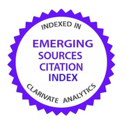Impacts of the pension reform on inclusive growth in the Dominican Republic
DOI:
https://doi.org/10.26360/2021_4Keywords:
private pensions, social security, economic growth, Latin AmericaAbstract
The paper studies the effects that individually funded pension schemes have on inclusive growth. For this, the reform introduced in 2001 in the Dominican Republic is analysed, one of the last to join the wave of reforms in the style of the “Chilean model” started in the eighties. Thus, it is found that the introduction of the individual savings system has led the Dominican Republic to grow more than one additional percentage point each year between the 2003-2019 period in its average estimates, which implies that for each point of growth it has experienced the Dominican GDP, 22% is explained by the operation of the private pension system. It has also been found that the annual impact on the saving-investment ratio has been 0.89% per year, which has resulted in the country's financial development index improving at an additional 0.21% per year and that the rate differential interest has been
reduced by an average of 3.15% during the study period. As part of the virtuous circle fostered by the private pension system since its introduction, thanks to the operation of the private pension system, today the poverty rate
Downloads
References
Acemoglu, D., Johnson S., y Robinson, J. A. (2005). Institutions as a fundamental cause of long run growth. En Aghion, P. y Durlauf, S. (Ed.) Handbook of Economic Growth 1A (pp. 386-472). Ed. Elsevier.
Adams, R. (2002). Economic growth, inequality and poverty: findings from a new data set. Policy Research Working Paper Nº 2972. World Bank. http://hdl.handle.net/10986/19109
Aghion, P., y Bolton, P. (1997). A theory of trickle-down growth and development with debt-overhang. Review of Economic Studies, 64(2), 151-172. https://www0.gsb.columbia.edu/faculty/pbolton/PDFS/A_Theory%20of%20Trickle%20Down.pdf
Alesina, A., y Peroti, R. (1995). Fiscal expansion and fiscal adjustment in OECD countries. Economic Policy, 10 (21), 205-248. https://academic.oup.com/economicpolicy/article-abstract/10/21/205/2392283?redirectedFrom=fulltext
Alonso, J., Sánchez, R., y Tuesta, D. (2014). Un modelo para el sistema de pensiones en el Perú. Revista de Estudios Económicos. 27, 81-98. Banco Central de Reserva del Perú. https://www.bcrp.gob.pe/docs/Publicaciones/Revista-Estudios-Economicos/27/ree-27-alonso-sanchez-tuesta.pdf
Alonso, J., Hoyo, C., y Tuesta, D. (2015). A model for the pension system in Mexico: diagnosis and recommendations. Journal of Pension Economics and Finance, 14 (1), 76-112. https://doi.org/10.1017/S147474721400016X
Anand, R., Mishra, S., y Peiris, S. (2013). Inclusive growth: measurement and determinants. Working Paper Nº 13/135. International Monetary Fund. https://www.imf.org/external/pubs/ft/wp/2013/wp13135.pdf
Ando, A., y Modigliani, F. (1963). The life cycle hypothesis of saving: aggregate implications and tests. American Economic Review, 53(1), 55-84. https://www.jstor.org/stable/1817129
Aportela, F. (1999). Effects of financial access on savings by low-income people. National Bureau of Economic Research. http://users.nber.org/~rdehejia/!@$devo/Lecture%2006%20Microcredit/supplemental/Aportela.pdf
Apoyo (2010). Importancia del desarrollo del sistema de pensiones en el Perú. Apoyo Consultoría. Reporte privado.
Arellano, A., Alonso, J., y D. Tuesta (2016). Pension fund investment in infrastructure and global financial regulation. En Mitchell, O., Maurer, R., and Orzag, M. (Ed.) Retirement system risk management: Implications of the new regulatory order (pp. 186-211). Oxford University Press.
Ashraf, N., Aycinena, C., Martinez, A., y Yang, D., (2011). Remittances and the problem of control: A field experiment among migrants from El Salvador. Serie de Documentos de Trabajo Nº 341. Facultad de Economía y Negocios de la Universidad de Chile. https://econ.uchile.cl/uploads/publicacion/c656462b3a49e7e526fd2223a0b1678697bfcf55.pdf
Ashraf, N., Karlan, D., y Yin, W., (2010). Female empowerment: Further evidence from a commitment savings product in the Philippines. World Development, 28 (3), 333-344. https://ashrafnava.files.wordpress.com/2016/07/femaleempowerment_worlddev.pdf
Balassa, B. (1989). The effects of interest rates on savings in developing countries. Working Papers Nº 56. World Bank. https://documents1.worldbank.org/curated/en/117061468740193258/pdf/multi-page.pdf
Banco Mundial (07 de noviembre 2021). Datos de libre acceso del Banco Mundial. https://datos.bancomundial.org
Banerjee, A., y Newman, A. (1993). Occupational choice and the process of development. Journal of Political Economy, 101 (2), 274–298. https://www.jstor.org/stable/2138820
Banco Central de la República Dominicana (2020). Documento metodológico y de aplicaciones correspondiente a las matrices insumo-producto de la República Dominicana.
Banco Central de la República Dominicana (07 de noviembre de 2021-a)- Encuesta Nacional de Fuerza de Trabajo-ENFT https://www.bancentral.gov.do/a/d/2539-mercado-de-trabajo-enft
Banco Central de la República Dominicana (07 de noviembre de 2021-b) - Encuesta Nacional Continua de Fuerza de Trabajo. https://bancentral.gov.do/a/d/2541-encuesta-continua-encft
Beck, T., Demirgüç-Kunt, A., y Levine, R. (2007). Finance, inequality, and the poor. Journal of Economic Growth, 12 (1), 27-49. https://www.jstor.org/stable/40216113
Bosch, M, Melguizo, A., y Pagés, C. (2013). Mejores pensiones, mejores trabajos. Banco Interamericano de Desarrollo.
CEMCA-Consejo Monetario Centroamericano (07 de noviembre de 2021) Estadísticas históricas desde 1960 http://www.secmca.org/EH.html
Corbo, V., y Schmidt-Hebbel, K. (2003). Efectos macroeconómicos de la reforma de pensiones en Chile. En Federación Internacional de Administradoras de Fondos de Pensiones (Ed.) Resultados y desafíos de las reformas de pensiones (pp. 259-351). CIEDESS.
Datos Abiertos-Gobierno de la República Dominicana (07 de noviembre de 2021) https://datos.gob.do/dataset/tasa-de-pobreza-monetaria-general-y-extrema-por-regiones-de-desarrollo
Dupas, P., y Robinson, J. (2009). Savings constraints and microenterprise development: evidence from a field experiment in Kenya. National Bureau of Economic Research Working Paper Nº14693. https://www.nber.org/papers/w14693
Federal Reserve Bank of St. Louis (07 de noviembre de 2021). https://www.stlouisfed.org
Feldstein, M., y Horioka, C. (1980). Domestic saving and international capital flows. Economic Journal, 90 (358), 314–329. https://academic.oup.com/ej/article-abstract/90/358/314/5220006
Frey, C. B. (2019). The technological trap: capital, labor, and power in the age of automation. Princeton University Press.
Galor, O., y Zeira, J. (1993). Income distribution and macroeconomics. Review of Economics Studies, 60 (1), 35-56. https://pages.nyu.edu/debraj/Courses/Readings/GalorZeira.pdf
Gill, I., Packard, T., y Yermo, J. (2005). Keeping the promise of social security. The World Bank y Stanford University Press.
Gopinath, G. (2020). The Great Lockdown through the global lens of the IMF. International Monetary Fund Blog. June 16. https://blogs.imf.org/2020/06/16/the-great-lockdown-through-a-global-lens/ June 16.
Harberger, A. C. (1998). A vision of the growth process. The American Economic Review, 88 (1), 1-32. https://www.jstor.org/stable/116816
Herrera, C., y D. Tuesta (2014). A long-term perspective for pension fund portfolios in Chile, Peru and Mexico. The Journal of Investing, 23 (2), 74-91. https://joi.pm-research.com/content/23/2/74
IMF-International Monetary Fund (10 de noviembre de 2021). IMF data Access to macroeconomic and financial data. https://data.imf.org/?sk=388dfa60-1d26-4ade-b505-a05a558d9a42
Impavido, G., Musalem, A., y Catalan, M. (2000). Contractual savings or stock market development- Which leads? Policy Research Working Papers. World Bank. https://openknowledge.worldbank.org/handle/10986/21366
Kuznets, S. (1955). Economic growth and income inequality. The American Economic Review, 45 (1), 1-28. https://assets.aeaweb.org/asset-server/files/9438.pdf
Loayza, N. (2016). Informality in the process of development and growth. Working Paper 7858. World Bank. https://www.worldbank.org/en/events/2016/10/12/informality-in-the-process-of-development-and-growth
Modigliani, F., y A. Muralidhar (2004). Rethinking pension reform. Cambridge.
North, D. (1989). Institutions and economic growth: An historical introduction. World Development, 17 (9), 1319-1332.
Palacios, R. (2003). Pension reform in the Dominican Republic. Social Protection Discussion Paper Series. The World Bank. https://documents1.worldbank.org/curated/en/412731468770672941/pdf/29140.pdf
Ravallion, M. (2004). Pro-poor growth; a primer. Working Paper 3242. World Bank https://openknowledge.worldbank.org/handle/10986/14116
Ravallion, M., y Chen, S. (1997). What can new survey data tell us about recent changes in distribution and poverty? World Bank Economic Review, 11 (2), 357-82. https://elibrary.worldbank.org/doi/abs/10.1093/wber/11.2.357
Robles, E. (2020). Crecimiento de la productividad total de los factores en Costa Rica e inestabilidad macroeconómica. Revista de Ciencias Económicas, 39 (1), 1-24. Universidad de Costa Rica. https://revistas.ucr.ac.cr/index.php/economicas/article/view/47622/47331
Rodrik, D. (2007). One economics, many recipes: globalization, institutions and economic growth. Princeton University Press.
Rofman, R., Apella, I., y Vezza, E. (2015). Beyond contributory pensions: fourteen experiences with coverage expansion in Latin America. Directions in Development - Human Development. Washington, DC: World Bank. https://openknowledge.worldbank.org/handle/10986/20602
Scott, A., y L. Gratton (2020). The new long life. Bloomsbury SIPEN-Superintendencia de Pensiones (07 de noviembre de 2021). Estadística previsional. http://www.sipen.gov.do/index.php/estadisticas/estadistica-previsional
Sura Asset Management (2013). Contribución del sistema privado de pensiones al desarrollo económico de Latinoamérica: experiencias de Colombia, México, Chile y Perú. Sura Asset Management. https://cdn01.sura.net.pe/integra/webapps/cercania/prod/statics/downloadable/nosotros/contribucion-del-spp-al-desarrollo-economico-de-latinoamerica.pdf
Titelman, D., Vera, C., and Pérez-Caldentey, E. (2009). Pension System Reform in Latin America and Potential Implications for the Chinese Case. The Ideas Working Paper Series. https://www.networkideas.org/wp-content/uploads/2017/09/06_2009.pdf
World Bank (1994). Averting the Old Age Crisis: Policies to Protect the Old and Promote Growth. Washington DC. World Bank y Oxford University Press.
Zweifel, P., y Eisen, R. (2012). Insurance Economics. Springer.
Downloads
Published
How to Cite
Issue
Section
License
Copyright (c) 2022 Edgar Robles, David Tuesta, Diego Valero

This work is licensed under a Creative Commons Attribution-NonCommercial-NoDerivatives 4.0 International License.


















